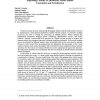Free Online Productivity Tools
i2Speak
i2Symbol
i2OCR
iTex2Img
iWeb2Print
iWeb2Shot
i2Type
iPdf2Split
iPdf2Merge
i2Bopomofo
i2Arabic
i2Style
i2Image
i2PDF
iLatex2Rtf
Sci2ools
122
click to vote
CF
2006
ACM
2006
ACM
Exploiting locality to ameliorate packet queue contention and serialization
Packet processing systems maintain high throughput despite relatively high memory latencies by exploiting the coarse-grained parallelism available between packets. In particular, multiple processors are used to overlap the processing of multiple packets. Packet queuing—the fundamental mechanism enabling packet scheduling, differentiated services, and traffic isolation—requires a read-modify-write operation on a linked list data structure to enqueue and dequeue packets; this operation represents a potential serializing bottleneck. If all packets awaiting service are destined for different queues, these read-modify-write cycles can proceed in parallel. However, if all or many of the incoming packets are destined for the same queue, or for a small number of queues, then system throughput will be serialized by these sequential external memory operations. For this reason, low latency SRAMs are used to implement the queue data structures. This reduces the absolute cost of serialization ...
| Added | 13 Jun 2010 |
| Updated | 13 Jun 2010 |
| Type | Conference |
| Year | 2006 |
| Where | CF |
| Authors | Sailesh Kumar, John Maschmeyer, Patrick Crowley |
Comments (0)

